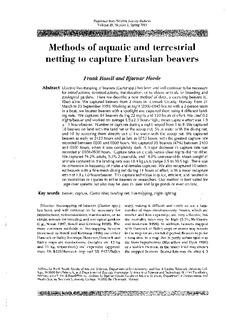| dc.description.abstract | Effective live-trapping of beavers (Castor spp.) has been and will continue to be necessary for introductions, re-introductions, translocation, or to obtain animals for breeding and zoological gardens. Here we describe a new method of directly capturing beavers (C. fiber) alive. We captured beavers from 3 rivers in Telemark County, Norway, from 31 March to 23 September 1999. Working at night (2000-0845 hours) with a 2-person team in a boat, we located beavers with a spotlight and captured them using 4 different landing nets. We captured 84 beavers during 22 nights and 130 hours of effort. We used 0.3 nights/beaver and worked on average 5.9±2.3 hours/night; mean capture effort was 1.9 ± 1.1 hours/beaver. Number of captures during a night ranged from 1 to 8. We captured 18 beavers on land with the land net or the scoopnet, 56 in water with the diving net, and 10 by scooping them directly out of the water with the scoop net. We captured beavers as early as 2120 hours and as late as 0755 hours, with the greatest capture rate recorded between 0200 and 0300 hours. We captured 39 beavers (47%) between 2400 and 0300 hours, when it was completely dark. A major decrease in capture rate was recorded at 0300-0500 hours. Capture rates on cloudy versus c1ear nights did not differ. We captured 76.2% adults, 9.5% 2-year-olds, and 14.3% one-year-olds. Mean weight of animals captured in the landing nets was 18.4 kg±6.6 (range 3.5 to 30.5 kg). There was no difference in frequency of males and females captured. We also recaptured 10 selected beavers with a fine-mesh diving net during 14 hours of effort, with a mean recapture effort of 1.8±1.0hours/beaver. This capture technique is quick, efficient, and resulted in no mortalities or injuries to either beavers or researchers. Our method is best suited for large river systems but also may be used in lakes and large ponds or even on land. | |
